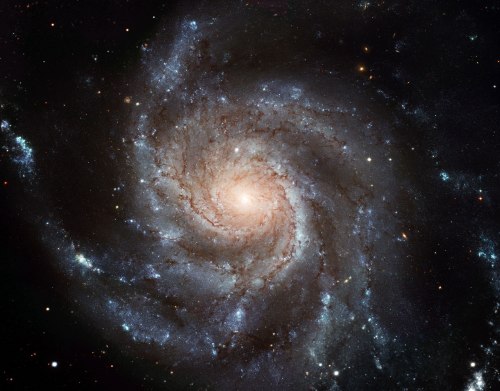I study galaxy evolution, or how galaxies grow and change over time. Ultimately, I want to know what physical processes govern these changes.
If you want some background for why I do what I do, check this out. Otherwise, here’s a brief rundown. If you’re already an expert, you can find my publications here.
What do I do?
I study how galaxies amass stars over time. They do this in two ways: by manufacturing them from their own gas, or by acquiring them through mergers. I concentrate on the manufacturing “mode”: the internal conversion of gas to stars in galaxies, or star formation. Specifically, I’m interested in how things like the shape, size, and environment of galaxies affect their ability to make new stars.1 These are key questions in galaxy evolution, and have been for a long time.
The Big Question
We call it galaxy “evolution” because galaxies can seem a lot like living creatures. For one thing, they have a life cycle: they are born (through the gravitational collapse of dark matter and gas), they grow (through making and agglomerating stars), and they die (they stop making stars). We want to understand this life cycle.
Some of what we know is illustrated in these two pictures.

Your average, healthy, star-forming galaxy. (Image: ESA/HST/CFHT/NOAO)

A galaxy that hasn’t had significant star formation in billions of years. (Image: NASA/ESA/HST)
On the left is the Pinwheel Galaxy. She is pretty representative of large, “healthy” galaxies. You can tell she’s forming stars at a good rate because she is blue and blue light comes only from new stars.2
On the right is a very different object: the central galaxy in a nearby galaxy cluster known as Abell S740. She is not a healthy galaxy: she hasn’t formed stars in perhaps a few billion years. We know this because her stellar population is about as red as one can get.3 Clearly, however, she is full of stars. At some point in the past, she must therefore have been a healthy galaxy like Pinwheel (left). So how, when, and why did she die?!
We don’t know — that’s why I work on this problem — but we have some hints.
Hints
We think that, as in biological systems, galaxy life-cycles are shaped by internal forces (nature), and external influences (nurture). Here are the principal nature/nurture examples my own work deals with:
On the “nature” side, notice that, besides their colors, the galaxies above have different shapes. The star-forming galaxy is disky and spiraled, as healthy galaxies — including our Milky Way — tend to be. On the other hand, the dead galaxy is more spherical / “smoother” in structure, as dead galaxies tend to be. There are good reasons why diskiness should correlate with ability to form stars, so morphological (or shape) transformations may play an important role in reducing star formation in galaxies. Yet, there are plenty of dead galaxies with big disks, so this can’t be the whole answer.
On the “nurture” side, the galaxies above live in different environments. The star-forming galaxy is relatively isolated, as healthy galaxies — including our Milky Way — tend to be. On the other hand, the dead galaxy is at the center of a rich cluster — a region containing dozens of galaxies, some of which are visible on the image. There are good reasons why environmental density should correlate with lack of ability to form stars, so the growth of clusters and groups may play an important role in reducing star formation in galaxies. However, plenty of dead galaxies don’t live in dense regions,4 and not all galaxies in dense regions are dead (see that blue gal below the big galaxy in the picture at right?), so environment is also not the whole story.
There are many other factors that, to one degree or another, probably contribute to the cessation of star formation: e.g., black holes (nature), major-mergers (nurture), the act of gaining mass itself (nature). There are also many complications that make disentangling them difficult: e.g., the fact that galaxies in dense environments tend also not to be disky (oy vey). There’s no space for me to discuss these here; with luck I’ll get to them as the blog part of this site develops. But, I hope what I have discussed conveys a sense of the richness of the lives of galaxies, and the amount of work that goes into understanding them!
Stay tuned,
– Louis
- The detailed physics of how individual gas clouds (much smaller than galaxies) actually turn into stars is another important area of research. Roughly, it is to genetics as what I do is to public health. ↩
- Galaxies form stars in batches. The brightest stars in each batch are blue, so actively star-forming galaxies look blue. Being bright, however, the blue stars also burn through their fuel supplies and die very quickly (i.e., within about 10 million years). So, in the absence of star formation, galaxies will redden with age. Hence, colors give astronomers insight into the last time galaxies formed a significant number of stars. ↩
- Indeed, we frequently refer to this class of galaxies as “red and dead”. Really though, we mean “they aren’t blue and thus haven’t formed stars recently” (see above). This colloquialism illustrates two interesting aspects of astronomers: 1) we only see in two colors (red and blue); 2) we like to associate observations (red) with physical states (dead). This last tendency is fine as long as you’re aware of it and realize that similar effects can arise from multiple causes. For example, dust can make a galaxy appear red, even though it’s perfectly healthy. File under: Why is astronomy hard? ↩
- Perhaps 5% of galaxies near the Milky Way’s stellar mass (about 1010.7 solar masses) live in clusters, but perhaps 50% of galaxies at the Milky Way’s mass are dead (or “quiescent”). ↩